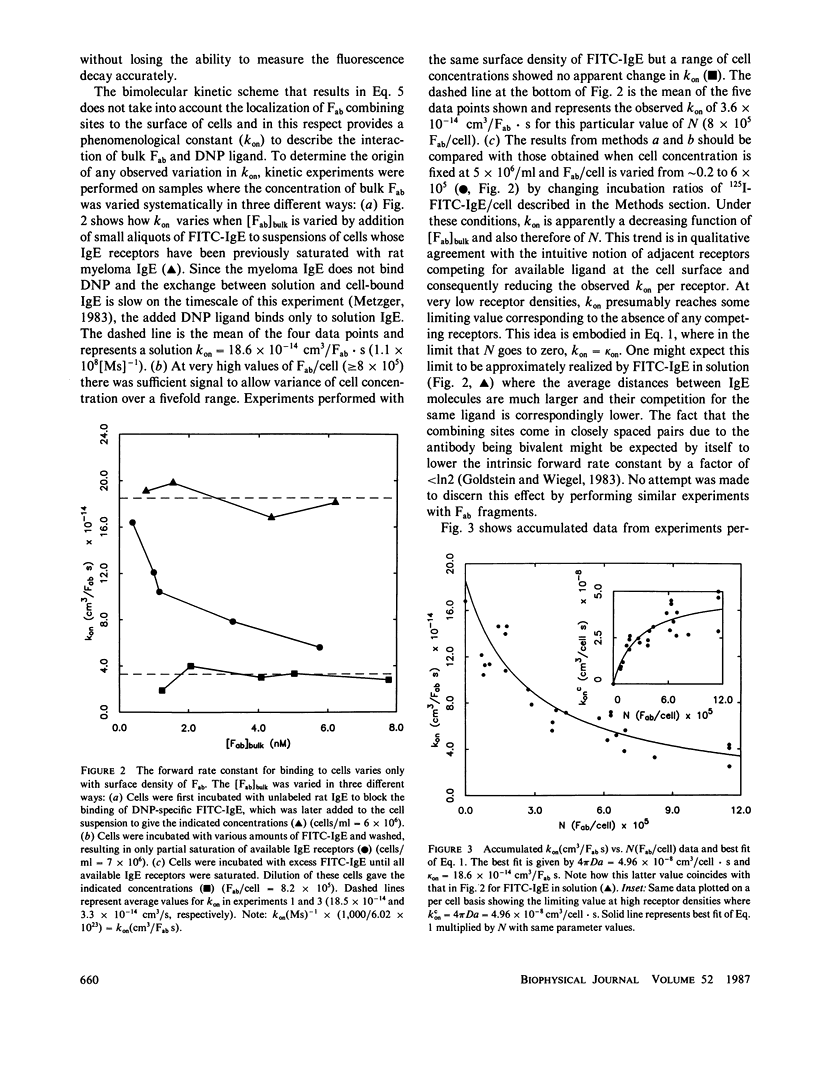Abstract
For monovalent ligands interacting with cell surface receptors we have directly observed the functional dependence of the forward rate constant on the number of receptors per cell (N). The experimental system we studied consisted of monovalent ligand, 2,4-dinitrophenyl (DNP)-aminocaproyl-L-tyrosine (DCT), binding to bivalent, monoclonal anti-DNP immunoglobulin E (IgE) anchored to its high affinity receptor on rat basophilic leukemia (RBL) cells. To measure the fractional occupation of antibody combining sites by DNP we employed a recently developed fluorescence technique (Erickson, J., Kane, B. Goldstein, D. Holowka, and B. Baird, 1986, Mol. Immunol., 72:769-781). Our results are well fitted by the equation (Berg and Purcell, 1977, Biophys. J., 20:193-219) konc = 4 pi DaN kappa on/[4 pi Da + N kappa on] where konc is the forward rate constant for binding to the cell, D is the diffusion constant of the ligand, a is the radius of the cell, and kappa on is the intrinsic forward rate constant describing a single IgE combining site-DNP interaction. If D is fixed at 10(-5) cm2/s, the best fit of accumulated data predicts an average cell radius of approximately 4 microns and kappa on of approximately 1.8 x 10(-13) cm3/s [1.1 x 10(8)(M . s)-1]; both in excellent agreement with RBL cell size and the single-site forward rate constant for the binding of DCT to IgE in solution, respectively. We believe this is the first report of experimental evidence that directly illustrates the effect of surface density in determining the rates of binding for small molecules to membrane receptors.
Full text
PDF





Selected References
These references are in PubMed. This may not be the complete list of references from this article.
- Barsumian E. L., Isersky C., Petrino M. G., Siraganian R. P. IgE-induced histamine release from rat basophilic leukemia cell lines: isolation of releasing and nonreleasing clones. Eur J Immunol. 1981 Apr;11(4):317–323. doi: 10.1002/eji.1830110410. [DOI] [PubMed] [Google Scholar]
- Berg H. C., Purcell E. M. Physics of chemoreception. Biophys J. 1977 Nov;20(2):193–219. doi: 10.1016/S0006-3495(77)85544-6. [DOI] [PMC free article] [PubMed] [Google Scholar]
- Brunn P. O. Absorption by bacterial cells: interaction between receptor sites and the effect of fluid motion. J Biomech Eng. 1981 Feb;103(1):32–37. doi: 10.1115/1.3138242. [DOI] [PubMed] [Google Scholar]
- DeLisi C. The biophysics of ligand-receptor interactions. Q Rev Biophys. 1980 May;13(2):201–230. doi: 10.1017/s0033583500001657. [DOI] [PubMed] [Google Scholar]
- DeLisi C. The effect of cell size and receptor density on ligand--receptor reaction rate constants. Mol Immunol. 1981 Jun;18(6):507–511. doi: 10.1016/0161-5890(81)90128-0. [DOI] [PubMed] [Google Scholar]
- DeLisi C., Wiegel F. W. Effect of nonspecific forces and finite receptor number on rate constants of ligand--cell bound-receptor interactions. Proc Natl Acad Sci U S A. 1981 Sep;78(9):5569–5572. doi: 10.1073/pnas.78.9.5569. [DOI] [PMC free article] [PubMed] [Google Scholar]
- Erickson J., Kane P., Goldstein B., Holowka D., Baird B. Cross-linking of IgE-receptor complexes at the cell surface: a fluorescence method for studying the binding of monovalent and bivalent haptens to IgE. Mol Immunol. 1986 Jul;23(7):769–781. doi: 10.1016/0161-5890(86)90089-1. [DOI] [PubMed] [Google Scholar]
- Goldstein B., Wiegel F. W. The effect of receptor clustering on diffusion-limited forward rate constants. Biophys J. 1983 Jul;43(1):121–125. doi: 10.1016/S0006-3495(83)84330-6. [DOI] [PMC free article] [PubMed] [Google Scholar]
- Hill T. L. Effect of rotation on the diffusion-controlled rate of ligand-protein association. Proc Natl Acad Sci U S A. 1975 Dec;72(12):4918–4922. doi: 10.1073/pnas.72.12.4918. [DOI] [PMC free article] [PubMed] [Google Scholar]
- Kane P., Erickson J., Fewtrell C., Baird B., Holowka D. Cross-linking of IgE-receptor complexes at the cell surface: synthesis and characterization of a long bivalent hapten that is capable of triggering mast cells and rat basophilic leukemia cells. Mol Immunol. 1986 Jul;23(7):783–790. doi: 10.1016/0161-5890(86)90090-8. [DOI] [PubMed] [Google Scholar]
- Liu F. T., Bohn J. W., Ferry E. L., Yamamoto H., Molinaro C. A., Sherman L. A., Klinman N. R., Katz D. H. Monoclonal dinitrophenyl-specific murine IgE antibody: preparation, isolation, and characterization. J Immunol. 1980 Jun;124(6):2728–2737. [PubMed] [Google Scholar]
- Metzger H. The receptor on mast cells and related cells with high affinity for IgE. Contemp Top Mol Immunol. 1983;9:115–145. doi: 10.1007/978-1-4684-4517-6_4. [DOI] [PubMed] [Google Scholar]
- Schwartz M. The adsorption of coliphage lambda to its host: effect of variations in the surface density of receptor and in phage-receptor affinity. J Mol Biol. 1976 May 25;103(3):521–536. doi: 10.1016/0022-2836(76)90215-1. [DOI] [PubMed] [Google Scholar]
- Shoup D., Szabo A. Role of diffusion in ligand binding to macromolecules and cell-bound receptors. Biophys J. 1982 Oct;40(1):33–39. doi: 10.1016/S0006-3495(82)84455-X. [DOI] [PMC free article] [PubMed] [Google Scholar]
- Taurog J. D., Fewtrell C., Becker E. L. IgE mediated triggering of rat basophil leukemia cells: lack of evidence for serine esterase activation. J Immunol. 1979 Jun;122(6):2150–2153. [PubMed] [Google Scholar]
- Wank S. A., DeLisi C., Metzger H. Analysis of the rate-limiting step in a ligand-cell receptor interaction: the immunoglobulin E system. Biochemistry. 1983 Feb 15;22(4):954–959. doi: 10.1021/bi00273a038. [DOI] [PubMed] [Google Scholar]


